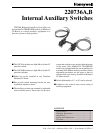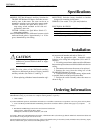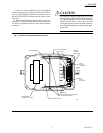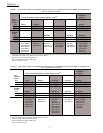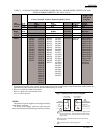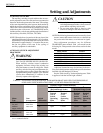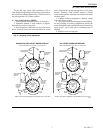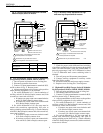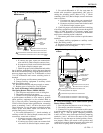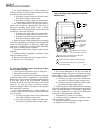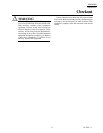
10
Fig. 8—Auxiliary switch adjustment for M6184,
M6194 motors.
4. For switch differential of 1°, check continuity of
auxiliary switch N.O. (Red to Purple) contacts and, with
screwdriver, rotate cam as follows:
a. If contacts are open, rotate cam clockwise until
N.O. (Red to Purple) contacts close.
b. If contacts are closed, rotate cam counterclock-
wise until N.O. (Red to Purple) contacts open.
5. For switch differential of 10°, the cams must be
rotated with screwdriver approximately 180° prior to
setting the switching action. Refer to Fig. 3. Check
continuity of the N.O. (Red to Purple) contacts and, with
screwdriver, rotate cam as follows:
a. If contacts are open, rotate cam counterclock-
wise until N.O. (Red to Purple) contacts close.
b. If contacts are closed, rotate cam clockwise until
N.O. (Red to Purple) contacts open.
6. Check for proper switch differential and switching
of auxiliary equipment by driving the motor through full
stroke (in both directions). If necessary, repeat steps
4 and 6 for 1° differential, or 5 and 6 for 10° differential
until correct switching action is obtained.
7. Disconnect power from switches or quick-connect
terminals.
8. Connect auxiliary equipment to auxiliary switch
leads. See Wiring section.
9. Reconnect controller and power supply to motor.
10. Replace cover of wiring box.
F) Series 61 Floating Control Non-Spring Return
Motors (M6184, M6194):
1. Turn off power and remove cover of wiring box.
2. Disconnect controller from motor.
3. Connect 24 Vac power and switches to drive motor
to position where auxiliary equipment is to be switched.
Refer to Fig. 8. Turn on power. Jumpering terminals R and
B will drive motor in the open direction, jumpering
terminals R and W will drive the motor in the closed
direction. To stop the motor at desired position,
disconnect jumpers. Motor will remain at this position
until connection is restored.
4. For switch differential of 1°, check continuity of
auxiliary switch N.O. (Red to Purple) contacts and rotate
cams as follows:
a. If contacts are open, rotate cam clockwise until
N.O. (Red to Purple) contacts close.
b. If contacts are closed, rotate cam counterclock-
wise until N.O. (Red to Purple) contacts open.
220736A,B
SETTINGS AND ADJUSTMENTS
5. For switch differential of 10°, the cams must be
rotated approximately 180° prior to setting the switching
action. Refer to Fig. 3. Check continuity of the N.O.
(Red to Purple) contacts and rotate cams as follows:
a. If contacts are open, rotate cam counterclock-
wise until N.O. (Red to Purple) contacts close.
b. If contacts are closed, rotate cam clockwise until
N.O. (Red to Purple) contacts open.
6. Check for proper switch differential and switching
of auxiliary equipment by driving the motor through full
stroke (in both directions). If necessary repeat steps
4 and 6 for 1° differential, or 5 and 6 for 10° differential
until correct switching action is obtained.
7. Disconnect 24 V power and switches.
8. Connect auxiliary equipment to auxiliary switch
leads. See Wiring section.
9. Reconnect controller and power supply to motor.
10. Replace cover of wiring box.
L2
L1
(HOT)
1
2
M 492B
1
2
3
Power supply. Provide disconnect means and
overload protection as required.
Transformer may be external or internal mounted.
Connect R-B to drive motor open. Connect R-W
to drive motor closed.
R
B
W
POWER END
OF MOTOR
LEFT/OUTER
AUXILIARY
SWITCH
RIGHT/INNER
AUXILIARY
SWITCH
STROKE ADJUST
CAMS (YELLOW)
OUTER AUXILIARY CAM (RED)
INNER AUXILIARY CAM (BLUE)
T1 T2
3
LEFT/OUTER
AUXILIARY
SWITCH



